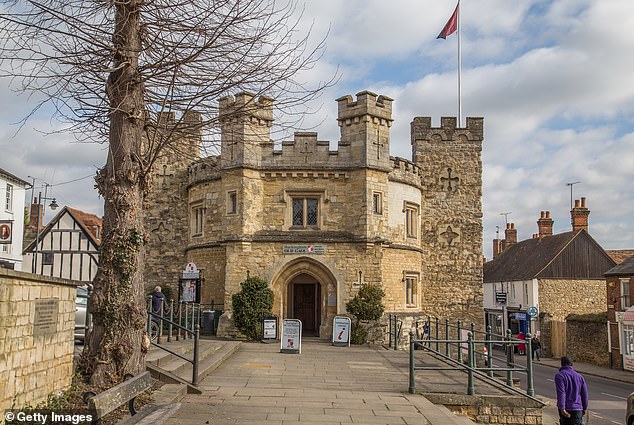I’m in jail but it’s highly enjoyable. The 18th century Old Gaol, built in the style of a mini-castle by the local architect Sir Gilbert Scott, is Buckingham’s landmark building.
In the past it often held poachers because Lord Cobham of nearby Stowe House was a strict enforcer of the Game Laws. Today, it’s a fascinating local history museum. Back in the tenth century, Buckingham was on the border between Saxon and Danish lands. It became an important frontier post when Edward the Elder, son of King Alfred, fortified the hill at the bend in the River Ouse.
Made county town and given a Royal Charter, its heyday was the medieval period when its market prospered (a thriving modern version is held every Tuesday and Saturday). In the museum, you learn the story of the Lenborough Hoard, the largest Anglo-Saxon coin find ever, discovered on nearby farmland in 2014. The treasure, from the reigns of Kings Aelthelred and Cnut, contained 5,248 silver pennies and two half pennies, valued at £1.3million.
A few years later, another exciting find came in the form of a rare gold ‘half-angel’ from the reign of Richard III, discovered by a metal detector enthusiast. The beautiful coin is the only one its kind on display anywhere. Buckingham is a rare example of a town contained within a river loop. After a good look around the museum, yet more insight into Buckingham’s past comes courtesy of local historian Ian Orton.
Ian explains that the town name derives from ‘meadow of Bucca’s people’, with Bucca being a prominent Anglo-Saxon settler. Meanwhile, the glory days ended with the Great Fire of 1725, which destroyed much of the centre and left more than 500 homeless.

Throwing off the shackles: On a tour of Buckingham, Neil Clark visits the Old Gaol Museum, which echoes a mini-castle

Buckingham’s heyday was the medieval period when its market prospered, says Neil, noting that a thriving modern version is held every Tuesday and Saturday

Stay the night: The four-star Villiers Hotel in Buckingham

Doubles at Villiers Hotel (pictured above) cost from £108 B&B

Villiers Hotel is a refurbished 16th-century coaching inn
Elegant Georgian architecture replaced the burnt-out buildings. For a taste of older, Tudor Buckingham, however, head to Church Street. Ian points out the half-timbered ‘Twisted Chimney House’ as well as a 16th-century manor house where Elizabeth I is reputed to have dined.
We walk past the 18th-century Buckingham Parish Church into the Old Churchyard, the site of the original 13th-century church and a plaque to the town’s very own saint, St Rumbold, buried in the church. Buckingham’s population fell between the 19th and 20th centuries, and in 1966 the Beeching axe saw the last freight trains at its station. The MP then was not someone the town probably wishes to remember – one Robert Maxwell (who represented Buckingham from 1964 to 1970).
But since the 1980s there’s been a revival, beginning with the foundation of the University of Buckingham, Britain’s first private university. Lady Thatcher was its second Chancellor, succeeding Lord Hailsham.

Neil learns that the town name derives from ‘meadow of Bucca’s people’, with Bucca being a prominent Anglo-Saxon settler

Neil stops at the White Hart (above), a ‘splendid’ 18th-century inn on Market Square

A ‘good lunch’ costs £8.99 at the White Hart (above), which has recently been refurbished

Doubles are available at the White Hart from £41 (greeneking.co.uk)

Pictured above is the White Hart’s bar, where Neil enjoys some liquid refreshment
You cannot help but admire the riverside campus with its weir and ancient mill. The setting made me wish I was an undergraduate all over again.
After the tour it was time for liquid refreshment in the White Hart, a splendid 18th-century inn on Market Square, where a good lunch costs £8.99.
Buckingham may have lost its county town status to Aylesbury 500 years ago, but it’s retained a status all of its own.
This article was originally published by a www.dailymail.co.uk . Read the Original article here. .


